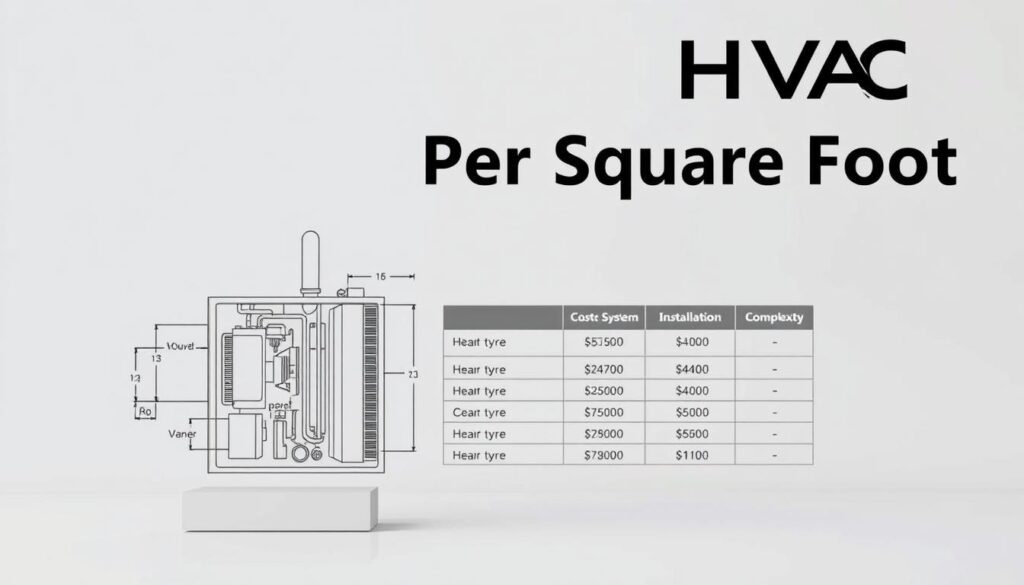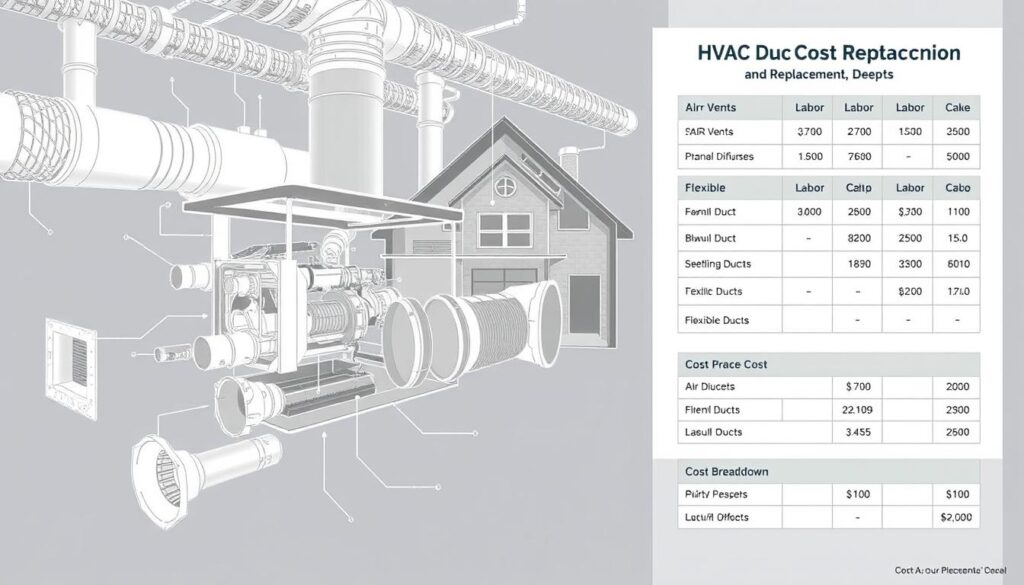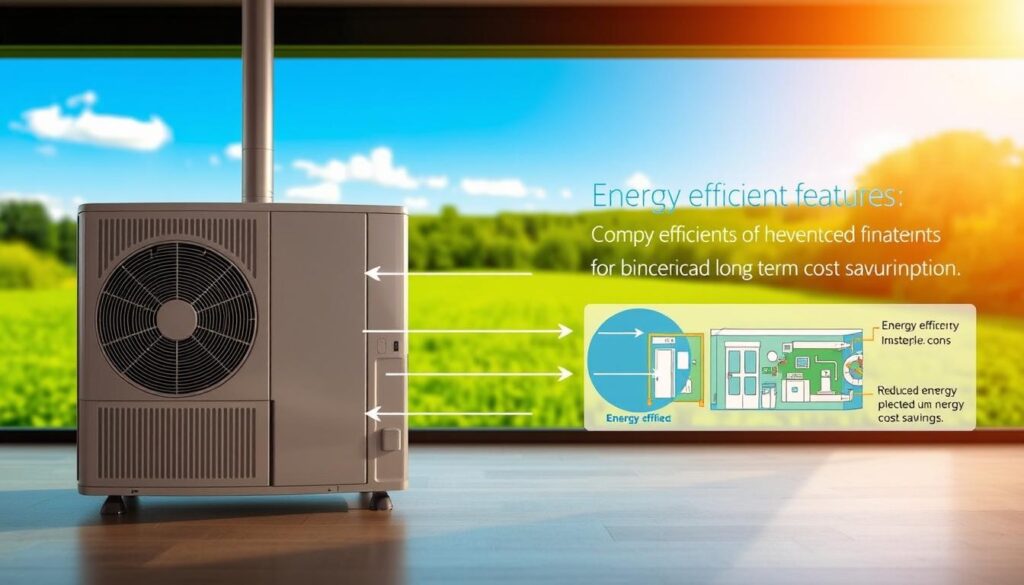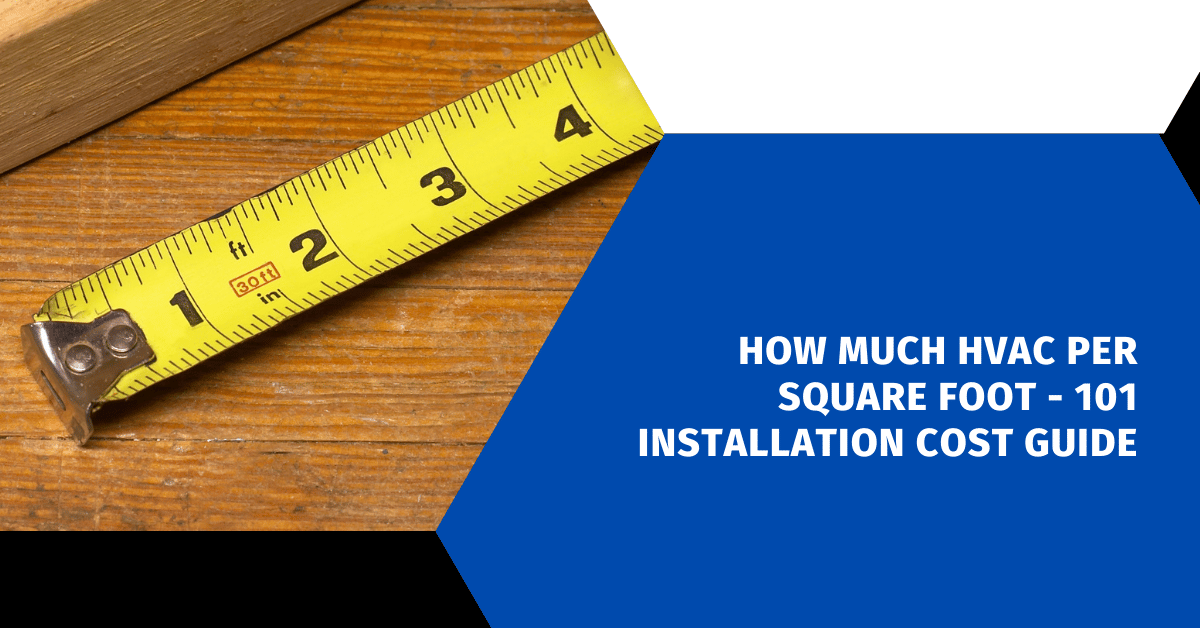Affiliate Disclosure
HVAC Guide Guys is a participant in the Amazon Services LLC Associates Program, an affiliate advertising program designed to provide a means for sites to earn advertising fees by advertising and linking to Amazon.
How Much HVAC Per Square Foot? Ever wondered why your neighbor’s HVAC system cost so much? The world of HVAC installation costs is complex. Prices change based on many factors that homeowners often don’t get.

When you think about getting an HVAC system, knowing the cost per square foot is key. The average cost for installation is between $5,000 and $12,500. But, this can change a lot based on your home, the system you choose, and where you live.
This guide will cover everything you need to know about HVAC installation costs. We’ll talk about system types and what affects prices. We aim to help you understand the costs of heating and cooling your home.
Key Takeaways
- HVAC costs vary widely based on home size and system complexity
- Average installation ranges between $5,000 and $12,500
- Square footage plays a critical role in determining overall costs
- Energy efficiency impacts long-term investment value
- Professional assessment is key for accurate pricing
Table of Contents
Understanding HVAC System Basics and Costs
Choosing the right HVAC system for your home is key. It involves knowing the basics and what affects prices. Your home’s comfort depends on picking a system that fits your needs and space.
HVAC systems are complex networks of heating, ventilation, and air conditioning. They are designed to create the best indoor environments. The right size of your HVAC system is important for energy efficiency and comfort.
Types of HVAC Systems Available
- Central Air Conditioning Systems: Best for whole-home cooling and heating
- Heat Pump Systems: Efficient for moderate climates
- Ductless Mini-Split Systems: Ideal for targeted temperature control
- Packaged HVAC Units: Compact solutions for smaller spaces
Core Components of an HVAC System
A complete HVAC system has several key parts. They work together to control your home’s temperature and air quality:
- Heating Unit (Furnace or Heat Pump)
- Cooling Unit (Air Conditioner)
- Ductwork for Air Distribution
- Thermostat and Control Systems
Average Installation Timeframes
How long it takes to install varies. It depends on the system’s complexity and your home’s size. Here’s what you can expect:
- Central Air Systems: 1-3 days
- Ductless Mini-Splits: 1 day
- Comprehensive HVAC Replacement: 3-5 days
Professional installation ensures optimal performance and longevity of your HVAC system.
How Much HVAC Per Square Foot: Complete Pricing Breakdown
When planning a new heating and cooling system for your home, knowing the hvac price per square foot is key. Homeowners usually spend between $3 to $6 per square foot for a full HVAC installation. This cost includes the system, equipment, and professional installation.
Using an hvac square footage calculator can help estimate your project costs. These tools give insights into your expenses based on your home’s size and needs.
- Basic system costs range from $3-$6 per square foot
- Pricing varies by home size and system complexity
- Factors influencing cost include home layout and existing infrastructure
Your total investment depends on several key factors:
- Home square footage
- System efficiency rating
- Local climate conditions
- Specific equipment chosen
Pro tip: Always get multiple quotes from certified HVAC professionals to ensure you’re getting the most accurate pricing for your specific needs.
Investing in the right HVAC system can save you money on energy costs in the long run.
Explore Our HVAC Shop
Looking for top-rated HVAC tools, parts, and accessories? Visit our shop and find the perfect solution for your needs.
Visit the ShopHVAC Installation Costs by Home Size
When it comes to HVAC installation, the size of your home matters a lot. The square footage of your home affects the type of system you need and the cost.
Different homes need different HVAC setups. The size of your home influences the complexity of the installation, the system’s capacity, and the total cost.
Small Homes (Under 1,500 sq ft)
Small homes usually have lower HVAC installation costs. Here are some key points to consider:
- Smaller, more efficient units
- Lower total system capacity
- Reduced labor and materials
Medium Homes (1,500-2,500 sq ft)
Medium-sized homes fall into the most common price range for HVAC installation. Costs typically range from $6,000 to $12,000 for a full system replacement.
| Home Size | Average HVAC Cost | Unit Capacity |
|---|---|---|
| 1,500-2,000 sq ft | $6,000-$8,500 | 3-4 tons |
| 2,000-2,500 sq ft | $8,500-$12,000 | 4-5 tons |
Large Homes (2,500+ sq ft)
Large homes need more powerful HVAC systems. This means higher costs due to the complexity and system needs.
- Larger unit capacities (5+ tons)
- More extensive ductwork
- Higher energy efficiency needs
Pro tip: Always get multiple quotes and consider your specific home’s unique characteristics when budgeting for HVAC installation.
HVAC Unit Costs by Brand and Manufacturer
Choosing the right HVAC unit is key. It affects both the cost upfront and how well it works over time. Top brands have different prices and features that can change what HVAC contractors charge.
Many well-known manufacturers have their own pricing:
- Carrier: Known for reliable mid-range systems
- Trane: Premium brand with higher upfront costs
- Lennox: Focuses on high-efficiency units
- Rheem: Budget-friendly option with solid performance
HVAC units cost between $1,000 to $6,000. This depends on the brand, how complex the system is, and its efficiency. A 3-ton unit usually costs between $1,700 and $5,000.
| Brand | Price Range | Efficiency Rating |
|---|---|---|
| Carrier | $2,000 – $4,500 | 14-18 SEER |
| Trane | $3,000 – $6,000 | 16-22 SEER |
| Lennox | $2,500 – $5,500 | 13-26 SEER |
| Rheem | $1,500 – $3,500 | 14-20 SEER |
Your budget and what you need for your home should help pick a brand. While high-end brands have more features, cheaper options can work well too. Always talk to HVAC experts to find the best system for you.
Explore Our HVAC Shop
Looking for top-rated HVAC tools, parts, and accessories? Visit our shop and find the perfect solution for your needs.
Visit the ShopUnderstanding SEER Ratings and Efficiency Costs
When you’re looking at the cost of installing an HVAC system, it’s key to know about SEER ratings. SEER stands for Seasonal Energy Efficiency Ratio. It shows how well your HVAC unit cools your space. This affects your energy bills over time.
The latest SEER2 ratings give a clearer picture of your system’s performance. They range from 13.4 to 23.6. This change helps homeowners see how efficient their systems are and how much they can save.
Standard Efficiency Units (13-16 SEER)
Standard efficiency units are the basic level for HVAC systems. They usually come with:
- Lower upfront costs
- Basic energy efficiency
- Good for areas with moderate climates
High Efficiency Units (17-21 SEER)
High efficiency units offer better performance and energy savings. They have:
- Less energy use
- Lower monthly bills
- Consistent temperatures
Premium Efficiency Units (22+ SEER)
Premium efficiency units are the top of the line in HVAC technology. They provide:
- Biggest energy savings
- Higher initial cost
- Advanced climate control
| SEER Rating | Efficiency Level | Estimated Annual Savings |
|---|---|---|
| 13-16 SEER | Standard | $0-$100 |
| 17-21 SEER | High | $100-$300 |
| 22+ SEER | Premium | $300-$500 |
Pro tip: While higher SEER ratings mean better efficiency, think about the initial cost and long-term savings for your needs.
Ductwork Installation and Replacement Costs

Ductwork is key to your HVAC system’s performance and your budget. The cost of ductwork varies a lot, from $2,000 to $10,000. This depends on several important factors.
The size of your home affects the cost of ductwork. Bigger homes need more ducts, which raises the cost. Several things affect ductwork prices:
- Home square footage
- Duct material quality
- System complexity
- Existing ductwork condition
- Home layout and accessibility
Duct materials have different prices. Flexible ductwork is cheaper, but sheet metal ducts last longer and cost more. Older homes might need new ducts, which can increase costs a lot.
Professional HVAC installers charge $10 to $25 per foot for ductwork. Home design, access, and local rates can raise these prices. Always compare quotes to find the best deal for your ductwork needs.
“Proper ductwork is as critical to your HVAC system as the unit itself. Invest wisely for long-term performance.” – HVAC Industry Expert
Explore Our HVAC Shop
Looking for top-rated HVAC tools, parts, and accessories? Visit our shop and find the perfect solution for your needs.
Visit the ShopLabor Costs and Installation Factors
When planning your HVAC installation, it’s key to know about labor costs and installation factors. These elements greatly affect your project’s budget. Understanding them helps you budget better.
HVAC contractors usually charge between $75 to $150 per hour. This reflects their specialized skills and knowledge. They ensure your system works well and safely.
Regional Price Variations
HVAC estimates vary by location. Urban areas with higher costs have more expensive labor rates. Rural areas are often cheaper. Several factors influence these prices, including:
- Local market competition
- Cost of living
- Demand for HVAC services
- Complexity of local building codes
Installation Complexity Factors
The complexity of your HVAC installation affects labor costs. Important factors include:
- Home layout and accessibility
- Existing ductwork condition
- System type and size
- Structural modifications required
“Every HVAC installation is unique, and complexity can significantly influence overall project costs.” – HVAC Industry Expert
Permit and Inspection Fees
Local governments often need permits for HVAC installations. These fees are between $100 to $250. They ensure your project meets safety and building standards. HVAC contractors will help with these and include them in their estimates.
Knowing these labor cost factors helps you prepare for your HVAC installation. It also helps avoid unexpected expenses.
Additional HVAC Components and Add-ons
Improving your HVAC system is more than just the basics. Homeowners can enhance comfort and air quality with extra components. These upgrades might raise the initial cost but offer lasting benefits.
Discover valuable HVAC add-ons that boost your home’s comfort and air quality:
- Smart Thermostats: Intelligent temperature control that reduces energy consumption
- Air Purification Systems: Remove allergens, dust, and pollutants from indoor air
- Whole-House Dehumidifiers: Manage moisture levels for improved comfort
- UV Germicidal Lamps: Eliminate harmful microorganisms in your HVAC system
Each add-on offers unique benefits for your home’s climate control. Smart thermostats can cut heating and cooling costs by up to 15%. Air purifiers greatly enhance indoor air quality, great for those with allergies. Dehumidifiers prevent mold and make your home more comfortable.
Investing in additional HVAC components is not an expense, but a strategic upgrade to your home’s comfort and health.
Before adding these upgrades, talk to HVAC experts. They can match your needs with the right components. This ensures your system works efficiently and effectively.
Explore Our HVAC Shop
Looking for top-rated HVAC tools, parts, and accessories? Visit our shop and find the perfect solution for your needs.
Visit the ShopEnergy Efficiency and Long-term Cost Savings
Getting an energy-efficient HVAC system changes how you think about costs. It’s not just about the initial price. The right system can save you money over time by using less energy.

Looking at the cost of an HVAC unit is more than the first price tag. Even though high-efficiency systems might cost more at first, they save you money later.
Annual Operating Costs
Your HVAC system’s yearly costs depend on a few things:
- Energy efficiency rating (SEER)
- Home insulation quality
- Local climate conditions
- System maintenance frequency
Energy Saving Features
Today’s HVAC systems have cool energy-saving tech:
- Programmable thermostats
- Variable-speed compressors
- Zoned heating and cooling
- Smart home integration
ROI Calculations
Figuring out your return on investment means comparing costs to savings. A high-efficiency system might cost more at first. But it can cut your yearly energy bills by 20-40%.
| SEER Rating | Initial Cost | Annual Energy Savings | Estimated ROI |
|---|---|---|---|
| 14 SEER | $3,500 | $200 | 5-7 years |
| 18 SEER | $5,500 | $400 | 3-5 years |
| 22 SEER | $7,500 | $600 | 2-4 years |
Pro tip: Talk to a professional HVAC technician to find the best deal for your home and energy needs.
Commercial vs Residential HVAC Pricing
Commercial HVAC systems are much more complex and expensive than residential ones. They need special designs and installations. This makes the hvac price per square foot higher.
Commercial and residential HVAC systems differ in several ways:
- Scale of installation
- System complexity
- Building code requirements
- Customization needs
Installing a commercial HVAC system can cost between $6,000 and $30,000. This depends on the size of the building and its specific needs. On average, it costs about $15 to $30 per square foot for office spaces.
| Property Type | Average HVAC Cost | Price per Square Foot |
|---|---|---|
| Small Office | $8,000 – $15,000 | $18-$22 |
| Medium Office | $15,000 – $25,000 | $22-$28 |
| Large Commercial Building | $25,000 – $30,000+ | $28-$35 |
When choosing a commercial HVAC system, consider several factors. Customization, energy efficiency, and long-term costs are key. They help find the best system for your business.
Professional HVAC contractors suggest a detailed assessment of your commercial space before choosing a system.
Investing in a commercial HVAC system is more than just the initial cost. Energy-efficient systems might cost more upfront. But, they can save a lot of money in the long run.
Explore Our HVAC Shop
Looking for top-rated HVAC tools, parts, and accessories? Visit our shop and find the perfect solution for your needs.
Visit the ShopUnderstanding Warranties and Maintenance Costs
Protecting your HVAC investment starts with knowing about warranties and maintenance. Central air conditioners and heat pumps last 10-15 years. Furnaces can last 15-20 years with the right care.
Most makers offer standard warranties for your HVAC system. These warranties affect your costs and expenses over time.
- Standard manufacturer warranties typically cover:
- Compressor: 5-10 years
- Parts: 1-5 years
- Labor: 1 year
Extended warranties offer more protection than standard ones. They cost more upfront but can save on repairs. You can choose from:
- Basic component coverage
- Comprehensive system protection
- Full replacement warranties
| Maintenance Type | Frequency | Estimated Cost |
|---|---|---|
| Annual Tune-up | Once per year | $75-$200 |
| Filter Replacement | Every 3-6 months | $10-$50 per filter |
| Comprehensive Inspection | Biannually | $150-$300 |
Regular maintenance keeps your HVAC system efficient and prevents breakdowns. Proactive care extends your system’s life and boosts performance. Experts say to get maintenance at least once a year for best results.
Investing in maintenance is far less expensive than replacing an entire HVAC system prematurely.
Conclusion
Figuring out the cost of HVAC per square foot needs careful planning and research. Your choice of a new heating and cooling system is more than just a price. It’s about balancing the cost now with savings later.
When looking at HVAC costs, remember that the cheapest option isn’t always the best. High-quality systems from brands like Carrier, Trane, and Lennox last longer and work better. Get quotes from certified contractors who can suggest the best system for your home.
Your goal is to create a cozy, energy-saving space without breaking the bank. A good HVAC system is an investment in your home’s comfort and value. It’s smart to think about both the cost now and the savings later.
This guide has given you the tools to understand HVAC pricing. You now know about square foot costs, efficiency, and installation details. With this knowledge, you can choose a system that fits your needs and budget.
FAQ
How much does HVAC installation typically cost per square foot?
What are the most common types of HVAC systems?
How do SEER ratings affect HVAC installation costs?
How long does a typical HVAC installation take?
What factors influence HVAC installation costs?
Do I need to replace ductwork during HVAC installation?
How much does HVAC installation typically cost per square foot?
What are the most common types of HVAC systems?
How do SEER ratings affect HVAC installation costs?
How long does a typical HVAC installation take?
What factors influence HVAC installation costs?
Do I need to replace ductwork during HVAC installation?
FAQ
How much does HVAC installation typically cost per square foot?
HVAC installation costs vary from to per square foot. This depends on your home’s size, the type of system, and its efficiency. Home layout, ductwork, and local labor rates also play a big role in the total cost.
What are the most common types of HVAC systems?
Common HVAC systems include central air conditioning and heat pumps. Ductless mini-split systems and gas furnace with air conditioning units are also popular. Each system has its own cost and efficiency level, fitting different homes and climates.
How do SEER ratings affect HVAC installation costs?
SEER ratings affect the cost of installation. Higher SEER ratings (17-21) increase costs by 20-40% but save energy in the long run. The highest efficiency units have 22+ SEER ratings but are the most expensive.
How long does a typical HVAC installation take?
HVAC installation usually takes 1-3 days. It depends on your system’s complexity, home size, and if ductwork needs to be replaced. Larger or more complex installations may take longer.
What factors influence HVAC installation costs?
Several factors influence costs. These include home size, system type, efficiency ratings, and brand. Ductwork condition, local labor rates, additional components, and climate also matter. Each factor can change your total cost.
Do I need to replace ductwork during HVAC installation?
You might need to replace ductwork if it’s old or damaged. Costs range from
FAQ
How much does HVAC installation typically cost per square foot?
HVAC installation costs vary from $4 to $10 per square foot. This depends on your home’s size, the type of system, and its efficiency. Home layout, ductwork, and local labor rates also play a big role in the total cost.
What are the most common types of HVAC systems?
Common HVAC systems include central air conditioning and heat pumps. Ductless mini-split systems and gas furnace with air conditioning units are also popular. Each system has its own cost and efficiency level, fitting different homes and climates.
How do SEER ratings affect HVAC installation costs?
SEER ratings affect the cost of installation. Higher SEER ratings (17-21) increase costs by 20-40% but save energy in the long run. The highest efficiency units have 22+ SEER ratings but are the most expensive.
How long does a typical HVAC installation take?
HVAC installation usually takes 1-3 days. It depends on your system’s complexity, home size, and if ductwork needs to be replaced. Larger or more complex installations may take longer.
What factors influence HVAC installation costs?
Several factors influence costs. These include home size, system type, efficiency ratings, and brand. Ductwork condition, local labor rates, additional components, and climate also matter. Each factor can change your total cost.
Do I need to replace ductwork during HVAC installation?
You might need to replace ductwork if it’s old or damaged. Costs range from $1,500 to $7,000, based on your home’s size and the installation’s complexity.
How much more expensive are high-efficiency HVAC systems?
High-efficiency systems cost 20-40% more than standard units. But, they save 30-50% on energy, making up for the higher initial cost over time.
What brands are considered top-tier for HVAC systems?
Top brands include Carrier, Trane, Lennox, Daikin, and American Standard. They offer quality systems with various prices, efficiency levels, and warranties to meet different needs.
How often should I replace my HVAC system?
HVAC systems usually last 10-15 years with proper care. Usage, maintenance, climate, and system quality affect lifespan. Regular maintenance can extend its life.
Are there any tax credits or rebates for HVAC installations?
Yes, there are tax credits for energy-efficient HVAC installations. The Inflation Reduction Act offers up to $2,000 for qualifying heat pumps. There are also incentives for high-efficiency systems.
,500 to ,000, based on your home’s size and the installation’s complexity.
How much more expensive are high-efficiency HVAC systems?
High-efficiency systems cost 20-40% more than standard units. But, they save 30-50% on energy, making up for the higher initial cost over time.
What brands are considered top-tier for HVAC systems?
Top brands include Carrier, Trane, Lennox, Daikin, and American Standard. They offer quality systems with various prices, efficiency levels, and warranties to meet different needs.
How often should I replace my HVAC system?
HVAC systems usually last 10-15 years with proper care. Usage, maintenance, climate, and system quality affect lifespan. Regular maintenance can extend its life.
Are there any tax credits or rebates for HVAC installations?
Yes, there are tax credits for energy-efficient HVAC installations. The Inflation Reduction Act offers up to ,000 for qualifying heat pumps. There are also incentives for high-efficiency systems.

